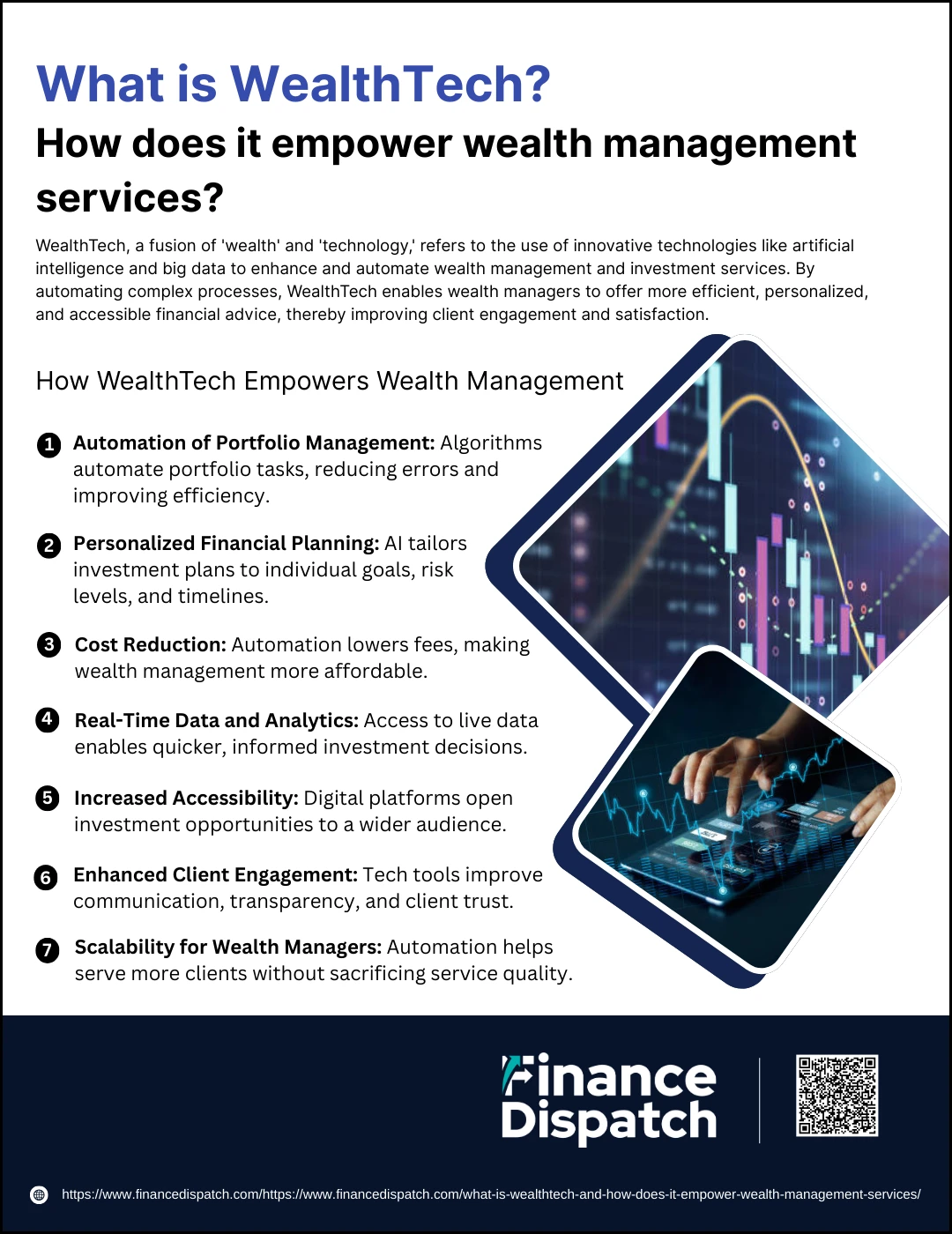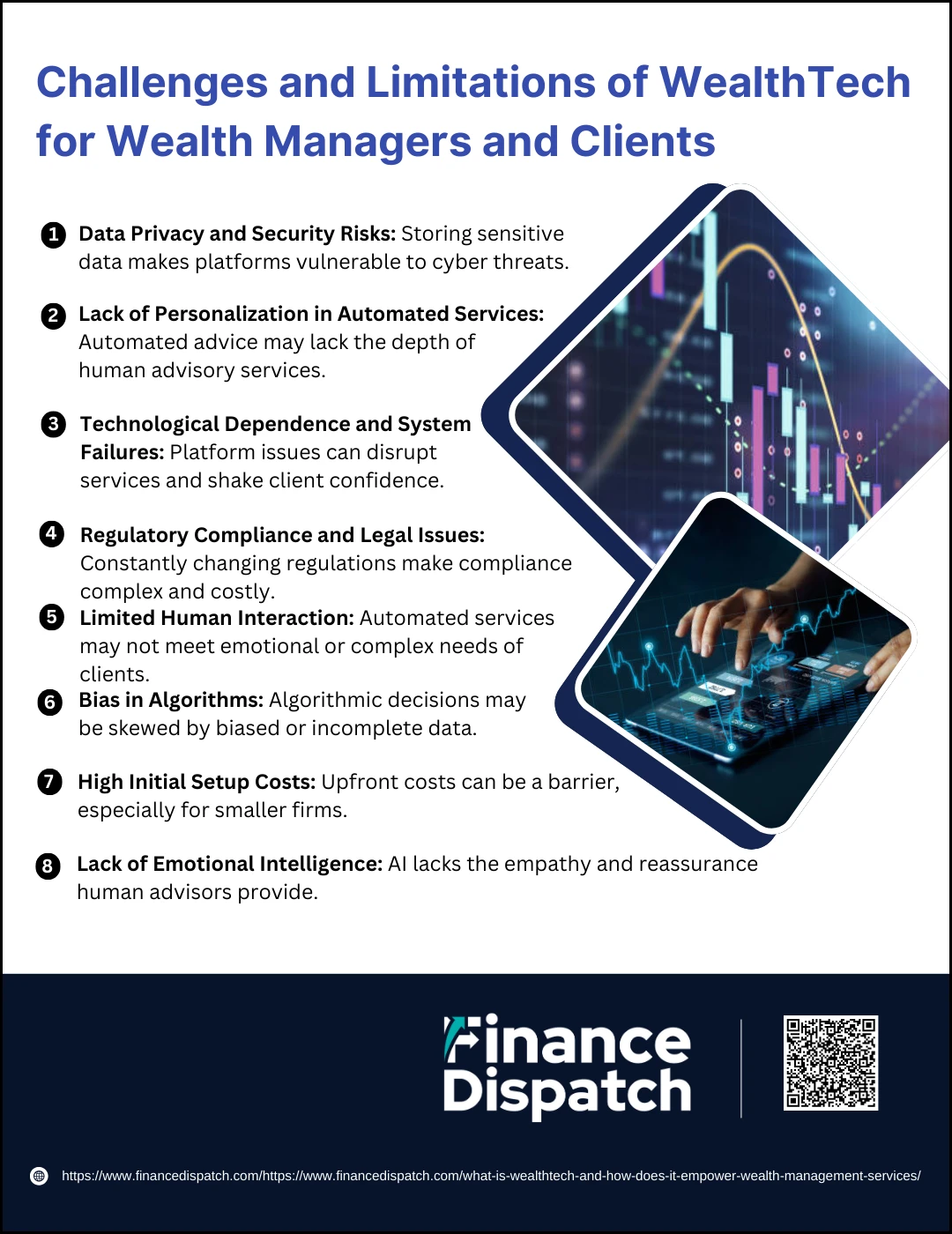WealthTech, a term that combines “wealth” and “technology,” refers to the innovative use of digital solutions in wealth management and financial services. As the world becomes increasingly digital, WealthTech is transforming how individuals and firms manage, invest, and grow their wealth. From robo-advisors and automated portfolio management to data-driven financial planning and personalized investment strategies, WealthTech is making financial services more efficient, accessible, and affordable. By leveraging cutting-edge technologies like artificial intelligence, blockchain, and big data, WealthTech empowers both wealth managers and clients to make smarter, data-backed decisions, ultimately enhancing the overall wealth management experience.
What is WealthTech?
WealthTech, short for “Wealth Technology,” is a subset of financial technology (FinTech) that focuses on enhancing and modernizing the wealth management industry through digital solutions. It encompasses a broad range of services and tools that leverage cutting-edge technologies such as artificial intelligence (AI), machine learning, big data analytics, and blockchain to provide more efficient, personalized, and accessible financial services. WealthTech innovations include robo-advisors, digital brokerage platforms, and personal finance management tools, all designed to streamline the investment process, reduce costs, and democratize access to wealth management. By automating complex financial tasks and providing tailored advice, WealthTech enables both individuals and financial institutions to make smarter, data-driven decisions, transforming traditional wealth management practices.
 How Does WealthTech Empower Wealth Management?
How Does WealthTech Empower Wealth Management?
WealthTech has revolutionized the wealth management landscape, not just by offering more efficient ways to manage investments, but by making financial services more personalized and accessible. By harnessing advanced technologies like artificial intelligence, machine learning, and big data analytics, WealthTech platforms provide wealth managers and clients with powerful tools to enhance decision-making and streamline processes. These technologies empower wealth managers to focus on delivering high-value, personalized advice, while also improving the overall client experience through automation and data-driven strategies. Here’s a more detailed look at how WealthTech empowers wealth management:
1. Automation of Portfolio Management
With WealthTech, managing and rebalancing portfolios is automated using sophisticated algorithms, ensuring that investment strategies are continuously optimized without requiring manual intervention. This reduces the risk of human error, increases operational efficiency, and ensures that portfolios are aligned with clients’ long-term financial objectives.
2. Personalized Financial Planning
WealthTech platforms leverage AI and data analytics to create highly customized investment plans for each individual based on their specific financial goals, risk tolerance, and time horizon. These personalized strategies go beyond generic advice, helping clients achieve their financial ambitions with precision and confidence.
3. Cost Reduction
Traditional wealth management services often come with high fees due to the need for manual processes and human advisors. WealthTech reduces these costs significantly by automating tasks like portfolio management, client onboarding, and financial planning, making wealth management more affordable and accessible to a broader audience, including those with smaller investment amounts.
4. Real-Time Data and Analytics
WealthTech platforms provide access to real-time market data and analytics, allowing wealth managers and clients to make timely, informed decisions. With continuous monitoring and advanced forecasting tools, investors can react quickly to changing market conditions, maximizing returns and minimizing potential risks.
5. Increased Accessibility
One of the most transformative aspects of WealthTech is its ability to make wealth management services available to a wider range of individuals. Low-cost platforms like robo-advisors and micro-investing tools allow even those with modest savings to access the same investment strategies that were once reserved for high-net-worth individuals, empowering a new generation of investors.
6. Enhanced Client Engagement
WealthTech fosters stronger relationships between wealth managers and clients through enhanced communication tools, such as secure messaging systems and video calls. Clients can access their portfolios at any time, track performance, and receive updates in real time. This transparency and constant access build trust and improve client satisfaction.
7. Scalability for Wealth Managers
WealthTech platforms allow wealth managers to serve a larger client base without sacrificing the quality of service. Automation handles routine tasks such as portfolio rebalancing and client reporting, allowing wealth managers to focus more on high-value activities, like providing strategic financial advice and building relationships. This scalability helps firms grow without the need for extensive increases in staff or operational costs.
Key Technologies Powering WealthTech
Key technologies are at the heart of WealthTech, driving its rapid growth and transformation within the wealth management industry. These innovations empower wealth managers and clients alike, enabling smarter, data-driven decisions, automating complex processes, and enhancing the overall efficiency of financial services. By leveraging cutting-edge technologies, WealthTech platforms are making wealth management more accessible, personalized, and cost-effective. Here are the key technologies powering WealthTech:
1. Artificial Intelligence (AI)
AI is used to analyze vast amounts of data and make predictions, enabling personalized investment strategies, portfolio optimization, and risk management. It also powers AI-driven robo-advisors, which provide tailored advice to clients at a lower cost than traditional advisors.
2. Machine Learning (ML)
Machine learning helps WealthTech platforms continually improve their algorithms by learning from new data and refining investment strategies. It enhances predictive analytics, helping wealth managers forecast market trends and identify investment opportunities with greater accuracy.
3. Big Data Analytics
WealthTech platforms utilize big data to gather and analyze information from various sources, such as market trends, financial performance, and client behavior. This data enables wealth managers to offer personalized, data-backed advice and optimize client portfolios based on real-time insights.
4. Blockchain Technology
Blockchain provides secure, transparent, and decentralized solutions for managing financial transactions, making it ideal for WealthTech platforms focused on asset management and digital brokerage. It ensures the integrity of data and enhances security in financial transactions, reducing the risk of fraud.
5. Cloud Computing
Cloud-based solutions offer scalable infrastructure for WealthTech platforms, enabling firms to manage large volumes of client data securely and cost-effectively. Cloud computing facilitates seamless access to financial services, empowering clients and wealth managers to collaborate in real time from anywhere in the world.
6. Robotic Process Automation (RPA)
RPA automates repetitive and time-consuming tasks, such as data entry, compliance checks, and portfolio rebalancing, freeing up wealth managers to focus on higher-value activities like client engagement and financial strategy.
7. Natural Language Processing (NLP)
NLP enables WealthTech platforms to interact with clients in a more intuitive and human-like manner, powering features like AI-driven chatbots and virtual assistants. These tools provide clients with instant responses, improving the overall client experience and enhancing communication.
 Benefits of WealthTech for Wealth Managers and Clients
Benefits of WealthTech for Wealth Managers and Clients
WealthTech has significantly transformed the wealth management industry by providing powerful tools that not only improve operational efficiency but also enhance the overall client experience. Through the integration of advanced technologies such as artificial intelligence, machine learning, and big data analytics, WealthTech platforms enable wealth managers to deliver highly personalized services while reducing costs. For clients, WealthTech opens doors to more affordable, data-driven, and tailored financial strategies, while providing greater transparency and control over their financial decisions. These benefits create a win-win situation where wealth managers can focus on high-value tasks, and clients enjoy better financial outcomes. Here’s a more detailed look at the key benefits of WealthTech for both wealth managers and clients:
1. Cost Efficiency
Traditional wealth management models often involve high fees due to labor-intensive processes and human intervention. WealthTech automates many of these tasks, such as portfolio rebalancing, compliance checks, and client reporting, significantly reducing overhead costs. This makes financial services more accessible to a wider range of clients, from those with high net worth to everyday investors seeking lower-cost options.
2. Personalized Financial Strategies
WealthTech platforms utilize AI and big data to develop investment strategies that are uniquely tailored to each client’s financial goals, risk profile, and time horizon. This level of personalization goes beyond what traditional wealth management services can offer, providing clients with a more nuanced approach to managing their wealth.
3. Improved Client Engagement
With WealthTech, clients have more control and access to their investments. Real-time tracking of portfolios, instant messaging with advisors, and video conferencing tools allow for more meaningful and transparent communication. Clients no longer have to wait for periodic statements or annual reviews; they can access their financial data anytime, making the relationship with wealth managers more dynamic and interactive.
4. Enhanced Decision-Making
WealthTech leverages the power of real-time data, predictive analytics, and machine learning algorithms to provide wealth managers with a clearer view of the market. This enables them to make better-informed decisions, respond more quickly to market changes, and identify investment opportunities more accurately. With these advanced tools, wealth managers can optimize portfolios for maximum return and risk management.
5. Scalability
One of the most compelling advantages of WealthTech is its ability to scale wealth management services without compromising the quality of service. By automating repetitive tasks, wealth managers can handle a larger client base and serve more clients efficiently. This scalability also allows firms to grow their businesses while maintaining a high level of personalized attention for each client.
4. Data Security and Compliance
WealthTech platforms incorporate cutting-edge security measures, such as blockchain and encryption, to safeguard client data and financial transactions. In addition, they are designed to help wealth managers stay compliant with evolving regulations by automating compliance processes, reducing the time and effort needed to stay up-to-date with legal requirements, and minimizing the risk of costly penalties.
5. Greater Accessibility
WealthTech platforms, particularly robo-advisors and micro-investing apps, have democratized access to wealth management services. Clients with lower investment amounts can now access high-quality investment advice and portfolio management tools. WealthTech has lowered the barriers to entry, allowing individuals who may have previously been excluded from traditional wealth management services to start investing and growing their wealth.
6. Automation of Repetitive Tasks
WealthTech reduces the burden of routine tasks through Robotic Process Automation (RPA). Tasks such as data entry, portfolio rebalancing, and generating reports are automated, freeing up valuable time for wealth managers to focus on more strategic and client-centric activities. This increased efficiency helps wealth managers allocate more time to nurturing relationships and offering higher-value services to clients.
 Challenges and Limitations of WealthTech for Wealth Managers and Clients
Challenges and Limitations of WealthTech for Wealth Managers and Clients
While WealthTech offers numerous benefits, it also presents challenges and limitations for both wealth managers and clients. As the industry continues to evolve, these obstacles must be addressed to ensure that WealthTech platforms remain effective, secure, and aligned with client needs. Issues such as data privacy concerns, the reliance on technology, and regulatory complexities can complicate the implementation and widespread adoption of WealthTech solutions. Below are the key challenges and limitations that WealthTech faces:
1. Data Privacy and Security Risks
As WealthTech platforms store and process sensitive financial data, they become prime targets for cyberattacks and data breaches. Despite advancements in security technologies like blockchain, wealth managers and clients must remain vigilant about the risks associated with data storage, particularly as regulations around data protection continue to evolve.
2. Lack of Personalization in Automated Services
While WealthTech platforms offer automated portfolio management and financial planning, the level of personalization may not match the tailored services provided by human advisors. Complex financial situations that require a nuanced, hands-on approach can be challenging for algorithm-driven solutions, potentially leaving clients with less customized advice.
3. Technological Dependence and System Failures
WealthTech heavily relies on technology, and technical glitches, system failures, or downtime can disrupt services and impact client portfolios. Wealth managers may face difficulties in managing client expectations during technical disruptions, and clients may lose trust if their investments are temporarily inaccessible or mismanaged due to system issues.
4. Regulatory Compliance and Legal Issues
The wealth management industry is highly regulated, and WealthTech platforms must comply with a complex and ever-changing set of financial regulations. For wealth managers, staying up-to-date with these regulations can be time-consuming and costly. Non-compliance or failure to meet legal requirements can result in penalties and loss of reputation.
5. Limited Human Interaction
Many WealthTech platforms replace traditional human advisors with automated services, reducing direct interaction between clients and financial professionals. While this may be cost-effective, it can lead to a less personal client experience. Clients with complex needs or those seeking emotional support during volatile market conditions may find the lack of human touch unsatisfactory.
6. Bias in Algorithms
WealthTech platforms rely on algorithms to make investment decisions, but these algorithms can be influenced by biases in the data they are trained on. If the data set is incomplete or flawed, it can lead to skewed investment strategies that do not align with clients’ true needs or risk profiles, undermining the platform’s effectiveness.
7. High Initial Setup Costs
For wealth management firms, adopting WealthTech solutions often requires a significant upfront investment in technology, staff training, and system integration. Smaller firms, in particular, may struggle with these initial costs, limiting their ability to implement or adopt WealthTech solutions at scale.
8. Lack of Emotional Intelligence
WealthTech platforms, despite their advanced capabilities, cannot replace the emotional intelligence and empathy that human advisors bring to the table. During times of market volatility or personal financial crises, clients may require more than just financial advice; they need reassurance and guidance that an algorithm cannot provide.
Case Studies: Real-World Applications of WealthTech
WealthTech has rapidly transformed the wealth management landscape, with numerous companies and platforms now offering innovative solutions that blend technology with financial services. From robo-advisors to digital brokerages, these real-world applications are reshaping how both wealth managers and clients interact with financial tools. By automating processes, improving decision-making, and offering personalized financial strategies, WealthTech platforms are creating more efficient and accessible wealth management solutions. Here are some notable case studies showcasing the impact of WealthTech in the industry:
1. Betterment
Betterment is a leading robo-advisor platform that uses algorithms to create personalized investment portfolios based on clients’ financial goals, risk tolerance, and time horizon. It allows users to invest in low-cost, diversified portfolios and provides automated rebalancing and tax optimization, making wealth management accessible to a broader audience at a fraction of the cost of traditional financial advisors.
2. Wealthfront
Wealthfront is another prominent robo-advisor that offers automated financial planning services, including retirement planning, tax optimization, and investment management. The platform uses machine learning algorithms to continuously refine its advice and portfolio strategies, ensuring clients receive data-driven and personalized guidance while minimizing fees.
3. Robinhood
Robinhood has revolutionized digital brokerage by offering commission-free trading in stocks, ETFs, options, and cryptocurrencies. The platform’s user-friendly interface and innovative features, like fractional share investing, have attracted millions of new investors, especially younger generations. Robinhood’s success has significantly lowered the barrier to entry for retail investors, allowing anyone to access financial markets with minimal capital.
4. Acorns
Acorns is a micro-investing platform that rounds up everyday purchases to the nearest dollar and invests the spare change into a diversified portfolio. By making investing effortless and automatic, Acorns has attracted millions of users, especially millennials who may not have large sums to invest but are eager to start building wealth gradually over time.
5. Personal Capital
Personal Capital combines robo-advisory services with personalized financial planning. The platform tracks users’ spending, investments, and retirement goals, providing insights into their financial health. With both automated tools and access to human advisors, Personal Capital offers a hybrid solution that balances the efficiency of technology with the personalized attention of financial professionals.
6. Stash
Stash is another micro-investing app that simplifies investing by allowing users to start with as little as $5. It provides a curated list of investment options based on individual financial goals and preferences. Stash also offers educational resources to help users understand investing and make more informed decisions about their portfolios.
7. SoFi Invest
SoFi offers a wide range of WealthTech products, including a robo-advisor platform for automated portfolio management, as well as an active investing platform that allows users to trade stocks and ETFs. SoFi integrates financial tools with a user-friendly interface, offering a seamless experience for both new and experienced investors looking for accessible and flexible wealth management.
Future of WealthTech in Wealth Management
The future of WealthTech in wealth management holds immense potential as it continues to evolve and reshape the industry. As technology advances, we can expect more sophisticated tools powered by artificial intelligence, machine learning, and big data analytics, offering even more personalized and efficient financial planning. The integration of blockchain technology could further enhance security and transparency in financial transactions, while advancements in natural language processing may allow for more intuitive client interactions with digital platforms. Additionally, WealthTech’s role in democratizing wealth management is expected to grow, making it accessible to a broader audience, including younger and less affluent investors. With the increasing demand for seamless, digital-first experiences, WealthTech is likely to drive further innovation, offering wealth managers and clients tools that improve decision-making, reduce costs, and ultimately help individuals achieve their financial goals with greater ease and precision. The future of WealthTech is undoubtedly one of greater inclusivity, efficiency, and advanced technological integration.
Conclusion
In conclusion, WealthTech is revolutionizing the wealth management industry by leveraging advanced technologies to create more efficient, personalized, and accessible financial services. From robo-advisors and digital brokerages to automated portfolio management and personalized financial planning, WealthTech platforms are transforming how both wealth managers and clients interact with the financial world. While challenges such as data security, regulatory compliance, and the need for human interaction remain, the benefits of WealthTech—cost reduction, scalability, real-time decision-making, and democratization of financial services—are clear. As technology continues to evolve, WealthTech will likely play an increasingly central role in shaping the future of wealth management, empowering individuals and financial institutions to make smarter, data-driven decisions and achieve their financial goals with greater ease and efficiency.



